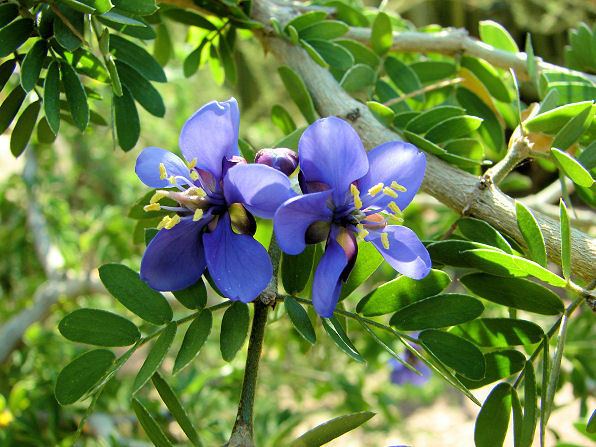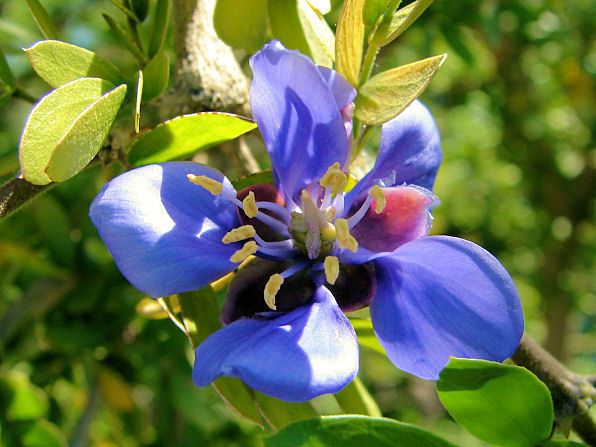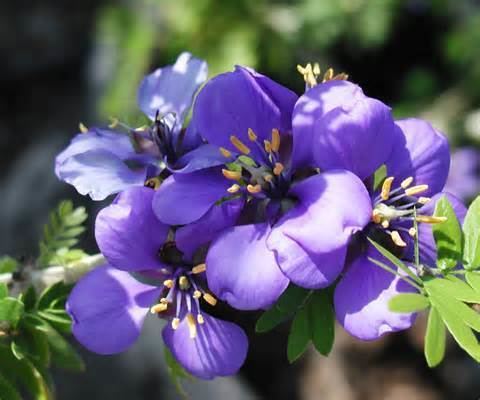Scientific name Guaiacum | ||
 | ||
Lower classifications Guaiacum officinale, Guaiacum sanctum, Guaiacum coulteri, Guaiacum angustifolium | ||
Guaiacum officinale
Guaiacum (/ˈɡwaɪ.ə.kəm/), sometimes spelled Guajacum, is a genus of flowering plants in the caltrop family Zygophyllaceae. It contains five species of slow-growing shrubs and trees, reaching a height of approximately 20 m (66 ft) but are usually less than half of that. All are native to subtropical and tropical regions of the Americas and are commonly known as lignum-vitae, guayacán (Spanish), or gaïac (French). The genus name originated in Maipurean, the language spoken by the native Taínos of the Bahamas; it was adopted into English in 1533, the first word in that language of American origin.
Contents

Members of the genus have a variety of uses, including as lumber, for medicinal purposes, and as ornamentals. The trade of all species of Guaiacum is controlled under CITES Appendix II.

Guaiacum officinale is the national flower of Jamaica, while Guaiacum sanctum is the national tree of the Bahamas.
Guaiacum officinale tree of life fruits
Uses

The genus is famous as the supplier of lignum vitae, which is the heartwood of several species in the genus. It is the hardest wood that is measured using the Janka hardness test, requiring a force of 4,500 L.f (20,000 N) to embed a steel ball 0.444 in (1.13 cm) in diameter a distance half of that into the wood.

The Spanish encountered guaiacum wood "when they conquered San Domingo; it was soon brought back to Europe, where it acquired an immense reputation in the sixteenth century as a cure for syphilis and certain other diseases.

Gum from the wood was used to treat syphilis; for example, Benvenuto Cellini records this use of it in his memoirs. Thomas Nashe refers to its supposed medical properties in his tract Nashe's Lenten Stuff, as well as to the exotic sound of the word at the time (playing on the famously bizarre-sounding Latin word honorificabilitudinitatibus, meaning "worthy of honour"): "Physicians deafen our ears with the Honorificabilitudinitatibus of their heavenly Panacaea, their sovereign Guiacum." Guaiacum resin has been used to treat a variety of medicinal conditions from coughs to arthritis. Wood chips can also be used to brew a tea.

The artist Jan van der Straet (also known as Johannes Stradanus) painted a scene of a wealthy man receiving treatment of syphilis with Guaiacum wood sometime around 1580. The title of the work is "Preparation and Use of Guayaco for Treating Syphilis." Epidemic syphilis had been raging through Europe for nearly a century at the time of the painting, and hopes were high that this plant from the New World would provide a cure. The richly colored and detailed work depicts four servants preparing the concoction while a physician looks on, hiding something behind his back while the hapless patient drinks.
Gum guaicum was used to stimulate menstruation, and at least one case in late eighteenth century Virginia suggests it was used as an abortifacient. One male physician noted "several physicians have apprehended mischief from the use of the guaiacum in a spirituous tincture." In a 1793 court case, Martha Jefferson Randolph testified that she had provided gum guaiacum to a female relative to "produce an abortion."
The 1955 edition of the Textbook of Pharmacognosy also says that: "Guaiacum has a local stimulant action which is sometimes useful in sore throat. The resin is used in chronic gout and rheumatism, whilst the wood is an ingredient in the compound concentrated solution of sarsaparilla, which was formerly much used as an alternative in syphilis."
A phenolic compound derived from the resin of Guaiacum trees is used in a common test for blood in human stool samples. The presence of heme in the blood causes the formation of a coloured product in the presence of hydrogen peroxide. The effect of peroxidases in horseradish on guiacum was first noted in 1810 by Planche.
As a food additive Guaiacum has the E number of E314 and is classified as an antioxidant.
A widely used derivative drug is the expectorant known as guaifenesin.
The soap fragrance oil of guaiac comes from Bulnesia sarmientoi, a South American tree from the same family.
Members of the genus are grown in Florida and California as ornamental plants.
